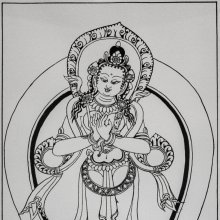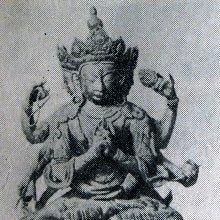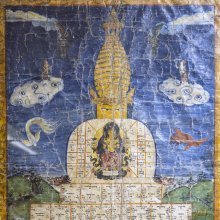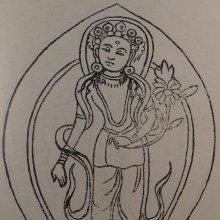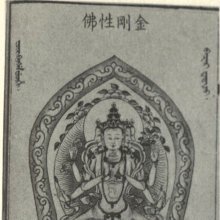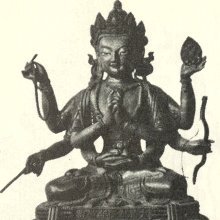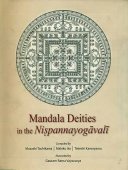Vajradhatu, Vajra-dhatu, Vajradhātu: 2 definitions
Introduction:
Vajradhatu means something in Buddhism, Pali. If you want to know the exact meaning, history, etymology or English translation of this term then check out the descriptions on this page. Add your comment or reference to a book if you want to contribute to this summary article.
Images (photo gallery)
(+1 more images available)
In Buddhism
Tibetan Buddhism (Vajrayana or tantric Buddhism)
Source: archive.org: The Indian Buddhist Iconography1) Vajradhātu (वज्रधातु) is another name for the four-faced variety of Vairocana, one of the Dhyāni-Buddhas, according to Vajrayāna or Tantric Buddhism.—[...] The four-faced of Vairocana is known as Vajradhātu and has the colour white and is eight-armed. He is described in the Akṣobhya-maṇḍala of the Niṣpannayogāvalī as follows:—“Vairocana is seated in Vajraparyaṅka and is white in colour. His four faces show white, yellow, red and green colours. He is eight-armed. With the two principal hands holding the Vajra he exhibits the Bodhyaṅgī or the Dharmacakra-mudrā. With the second pair of hands he shows the Dhyāna-mudrā. The two remaining right hands hold the rosary and the arrow, and with the two remaining left he carries the discus and the bow.”
2) Vajradhātu (वज्रधातु) or Vajradhātulokeśvara refers to number 91 of the 108 forms of Avalokiteśvara found in the Machhandar Vahal (Kathmanu, Nepal). [Machhandar or Machandar is another name for for Matsyendra.].
Accordingly,—
“Vajradhātu is identical with [Piṇḍapātra Lokeśvara] except that here the god displays the Varada mudrā in his right hand and holds the lotus in his left.—Piṇḍapātra Lokeśvara is one-faced and two-armed and stands on a lotus. He holds the Piṇḍapātra (the bowl) in his two hands near the navel”.
The names of the 108 deities [viz., Vajradhātu] possbily originate from a Tantra included in the Kagyur which is named “the 108 names of Avalokiteshvara”, however it is not yet certain that this is the source for the Nepali descriptions.Source: WikiPedia: Tibetan Buddhism
In Vajrayana Buddhism, the Diamond Realm is a metaphysical space inhabited by the Five Wisdom Buddhas. The Diamond Realm Mandala is based on an esoteric Buddhist sutra called the Vajrasekhara Sutra.
The Diamond Realm is a very popular subject for mandalas, and along with the Womb Realm (Garbhakosa) Mandala forms the Mandala of the Two Realms. This mandala, along with the Womb Realm, form the core of Japanese esoteric, or Shingon Buddhist, rituals, including the initiation or abhiseka ritual. In this ritual, new initiates are blindfolded, and are asked to toss a flower upon a mandala. Where the flower lands helps decide which Buddhist figure the student should devote themselves to.
In traditional Shingon Buddhist halls, the Diamond Realm Mandala is hung on the west wall symbolizing the final realization of Mahavairocana Buddha. In this setting, the Womb Realm Mandala is hung on the east wall, symbolizing the young stage of Mahavairocana Buddha.

Tibetan Buddhism includes schools such as Nyingma, Kadampa, Kagyu and Gelug. Their primary canon of literature is divided in two broad categories: The Kangyur, which consists of Buddha’s words, and the Tengyur, which includes commentaries from various sources. Esotericism and tantra techniques (vajrayāna) are collected indepently.
See also (Relevant definitions)
Partial matches: Vajra, Dhatu.
Starts with: Vajradhatulokeshvara, Vajradhatumahamandala, Vajradhatumandala, Vajradhatvishvari.
Ends with: Mahavajradhatu.
Full-text (+87): Mahastamaprapta, Sarvapayanjaha, Sarvanivaranavishkambhin, Jnanaketu, Sarvashokatamonirghatamati, Maitreya, Gandhahastin, Candraprabha, Sagaramati, Amitaprabha, Jaliniprabha, Gaganaganja, Pratibhanakuta, Akshayamati, Bhadrapala, Vajradhatumandala, Vajrayaksha, Vajramushti, Vajrasadhu, Vajraratna.
Relevant text
Search found 7 books and stories containing Vajradhatu, Vajra-dhatu, Vajra-dhātu, Vajradhātu; (plurals include: Vajradhatus, dhatus, dhātus, Vajradhātus). You can also click to the full overview containing English textual excerpts. Below are direct links for the most relevant articles:
The Indian Buddhist Iconography (by Benoytosh Bhattachacharyya)
The gods of northern Buddhism (by Alice Getty)
Blue Annals (deb-ther sngon-po) (by George N. Roerich)
Chapter 20 - Trophupa (iii): Khro phu lo tsa ba < [Book 8 - The famous Dakpo Kagyü (traditions)]
Chapter 10 - Phagmodru Lineage (xiii): bsod nams rgyal mtshan dpal bzang po < [Book 8 - The famous Dakpo Kagyü (traditions)]
A Dictionary Of Chinese Buddhist Terms (by William Edward Soothill)
Tibet (Myth, Religion and History) (by Tsewang Gyalpo Arya)
8. The Three Yanas < [Chapter 7 - Buddhism in Tibet]
Vietnamese Buddhist Art (by Nguyen Ngoc Vinh)
7. Buddhist monuments in Indonesia and Borobudur < [Chapter 2 - Similarity of Buddhist monuments in South Vietnam and South East Asia]
Related products
